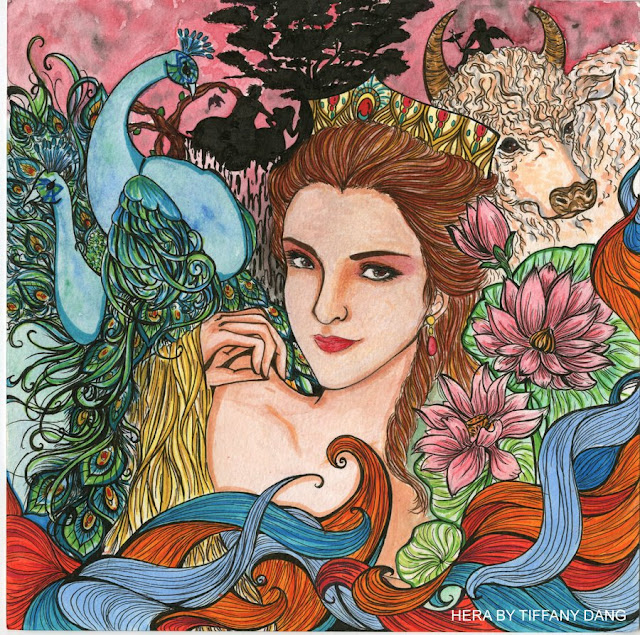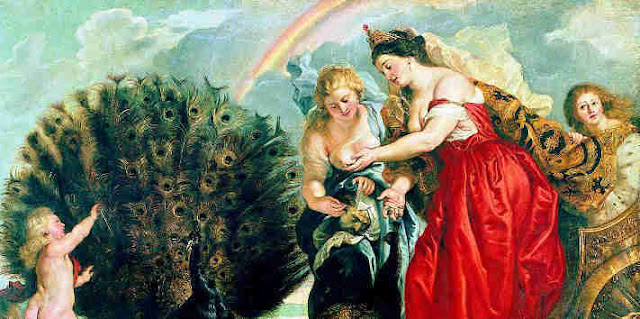HERA, daughter of Cronus and Rhea, having been born on the island of Samos or, some say, at Argos, was brought up in Arcadia by Temenus, son of Pelasgus. The Seasons were her nurses. After banishing their father Cronus, Hera's twin-brother Zeus sought her out at Cnossus in Crete or, some say, on Mount Thornax (now called Cuckoo Mountain) in Argolis, where he courted her, at first unsuccessfully. She took pity on him only when he adopted the disguise of a bedraggled cuckoo, and tenderly warmed him in her bosom. There he at once resumed his true shape and ravished her, so that she was shamed into marrying him.
b. All the gods brought gifts to the wedding; notably Mother Earth gave Hera a tree with golden apples, which was later guarded by the Hesperides in Hera's orchard on Mount Atlas. She and Zeus spent their wedding night on Samos, and it lasted three hundred years. Hera bathes regularly in the spring of Canathus, near Argos, and thus renews her virginity.
c. To Hera and Zeus were born the deities Ares, Hephaestus, and Hebe, though some say that Ares and his twin-sister Eris were conceived when Hera touched a certain flower, and Hebe when she touched a lettuce, and that Hephaestus also was her parthenogenous child - a wonder which he would not believe until he had imprisoned her in a mechanical chair with arms that folded about the sitter, thus forcing her to swear by the River Styx that she did not lie. Others say that Hephaestus was her son by Talos, the nephew of Daedalus.
1. Hera's name, usually taken to be a Greek word for 'lady', may represent an original Herwa ('Protectress'). She is the pre-Hellenic Great Goddess. Samos and Argos were the chief seats of her worship in Greece, but the Arcadians claimed that their cult was the earliest, and made it contemporary with their earth-born ancestor Pelasgus ('ancient'). Hera's forced marriage to Zeus commemorates conquests of Crete and Mycenaean - that is to say Cretanized-Greece, and the overthrow of her supremacy in both countries. He probably came to her disguised as a bedraggled cuckoo, in the sense that certain Hellenes who came to Crete as fugitives accepted employment in the royal guard, made a palace conspiracy and seized the kingdom. Cnossus was twice sacked, apparently by Hellenes: about 1700 BC, and about 1400 BC; and Mycenae fell to the Achaeans a century later. The God Indra in the Ramayana had similarly wooed a nymph in cuckoo disguise; and Zeus now borrowed Hera's sceptre, which was surmounted with the cuckoo. Gold-leaf figurines of a naked Argive goddess holding cuckoos have been found at Mycenae; and cuckoos perch on a gold-leaf model temple from the same site. In the well-known Cretan sarcophagus from Hagia Triada a cuckoo perches on a double-axe.
2. Hebe, the goddess as child, was made cup-bearer to the gods in the Olympian cult. She eventually married Heracles, after Ganymedes had usurped her office. 'Hephaestus' seems to have been a title of the sacred king as solar demi-god; 'Ares', a title of his war-chief, or tanist, whose emblem was the wild boar. Both became divine names when the Olympian cult was established and they were chosen to fill the roles, respectively, of War-god and Smith- god. The 'certain flower' is likely to have been the may-blossom: Ovid makes the goddess Flora - with whose worship the may-blossom was associated - point it out to Hera. The may, or whitethorn, is connected with miraculous conception in popular European myth; in Celtic literature its 'sister' is the blackthorn, a symbol of Strife - Ares's twin, Eris.
3. Talos, the smith, was a Cretan hero born to Daedalus's sister Perdix ('partridge'), with whom the mythographer is identifying Hera. Partridges, sacred to the Great Goddess, figured in the spring equinox orgies of the Eastern Mediterranean, when a hobbling dance was performed in imitation of cock-partridges. The hens were said by Aristotle, Pliny, and Aelian to conceive merely by hearing the cock's voice. Hobbling Hephaestus and Talos seem to be the same parthenogenous character; and both were cast down from a height by angry rivals - originally in honour of their goddess-mother.
4. In Argos, Hera's famous statue was seated on a throne of gold and ivory; the story of her imprisonment in a chair may have arisen from the Greek custom of framing divine statues to their thrones 'to prevent escape'. By losing an ancient statue of its god or goddess, a city might forfeit divine protection, and the Romans, therefore, made a practice of what was politely called 'enticing' gods to Rome- which by Imperial times had become a jackdaw's nest of stolen images. 'The Seasons were her nurses' is one way of saying that Hera was a goddess of the calendar year. Hence the spring cuckoo on her sceptre, and the ripe pomegranate of late autumn, which she carried in her left hand to symbolize the death of the year.
5. A hero, as the word indicates, was a sacred king who had been sacrificed to Hera, whose body was safely under the earth, and whose soul had gone to enjoy her paradise at the back of the North Wind. His golden apples, in Greek and Celtic myth, were passports to this paradise.
6. The annual bath with which Hera renewed her virginity was also taken by Aphrodite at Paphos; it seems to have been the purification ceremony prescribed to a Moon- priestess after the murder of her lover, the sacred king. Hera, being the goddess of the vegetative year, spring, summer, and autumn (also symbolized by the new, full, and old moon) was worshipped at Stymphalus as Child, Bride, and Widow (Pausanias).
7. The wedding-night on Samos lasted for three hundred years: perhaps because the Samian sacred year, like the Etruscan one, consisted of ten thirty-day months only: with January and February omitted (Macrobius). Each day was lengthened to a year. But the mythographers may here be hinting that it took the Hellenes three hundred years before they forced monogamy on Hera's people.


Comments
Post a Comment